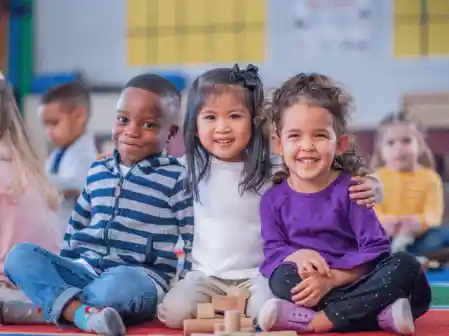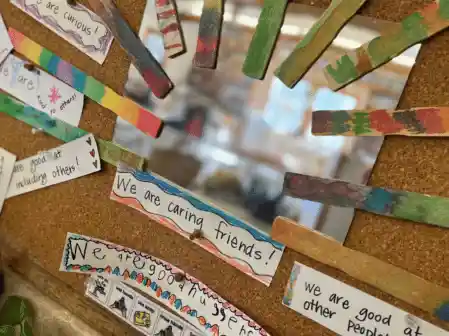Preschool Classroom Expectations

Establishing Classroom Expectations in Preschool and Pre-K
The first few weeks of school ... you’ve likely spent hours preparing your space and materials to make your classroom warm and welcoming. You’ve built a thoughtful daily schedule, cubbies are labeled, and there is a stack of favorite back-to-school read-alouds at your fingertips. What comes next?
These first days together can be a time of adjustment for children and teachers alike. As you work to build relationships and find your daily rhythm, teachers are also responsible for creating clear and consistent classroom expectations to keep everyone safe, engaged, and connected.
Your process for establishing community expectations and norms will be unique to your setting. Your program policies, culture, and curriculum may all be factors. Even the language used to refer to this process can be unique from one context to the next. “Classroom Rules,” “Community Agreements,” and “Class Expectations” are all phrases that refer to the same general concept – a set of clearly defined behavior indicators developed for the purpose of creating a safe classroom environment where everyone can learn and grow.
Keep It Simple
Condensing all the guidance and redirection that takes place throughout the day into only a handful of expectations can seem like a tall order. You might be familiar with the language of “Big Rule, Little Rule” from Creative Curriculum and the “Power of 3” from Blueprint for Early Learning. One thing they all have in common is the understanding that young children need simple and clearly stated expectations. Start by brainstorming three or four simply phrased rules that can encompass the overarching concepts of your agreements. The specifics of most classroom community agreements usually fall under three categories. I spent most of my career teaching Pre-K, and this is the language that I used for our group of four and five-year-olds:
-
Take Care of Ourselves
-
Take Care of Each Other
-
Take Care of Our Schools
Invite Children’s Input!
During the first days of school, share these guidelines and talk about what these phrases really mean. Brainstorm some more specific behaviors or rules that might fall under these agreements. Write these on sticky notes and sort them under the appropriate Agreement. For example, “Use walking feet” is a good way to be safe and take care of your body. “Use gentle hands” could be about being safe with friends’ bodies (Take Care of Each Other) or being gentle with materials (Take Care of Our School).
Identify and discuss the guidelines necessary for a safe and fun first few days, then let the children know that you’ll continue to collect suggestions and add them to the brainstorm board. As these moments come up throughout the day or when you gather as a class, invite children to share any rules or agreements that feel important for them. Continue to discuss and sort these suggestions as a group.
Use Positive Language
Name the behaviors that are helpful and productive instead of focusing on what NOT to do. For example, “Please use inside voices” is a positive way to reframe “No shouting!” But remember, not all teacher-talk is familiar to children. Make sure to explain and model what you mean by “inside voices” and “gentle hands.” Your time together might be the first time that children are hearing these phrases in a group setting. Engaging in role play with stuffed animals or puppets can be a fun way to make these concepts accessible for all of your students.

Make it Your Own! Creating Routines and Rituals Around Your Community Agreements
Building these agreements with your class can be a positive, affirming experience where children are part of the process of creating a classroom community that will be safe, nurturing, and joyful. Integrate language from children’s families, favorite books, or sayings that emerge throughout the year with your classroom. She was VERY tempted to eat her classmates, and at first, sometimes she just couldn’t resist. The children were adamant that we needed a rule that explicitly stated, “Eat FOOD, not classmates!”
Another year, the phrase “Don’t yuck my yum” was introduced from one child’s family expression encouraging kindness towards others’ choices, even if they’re not our own favorite things. The child brought it to our class conversation, and I suggested adding it to a sticky note, but the class reminded me, “We have to say what we DO want, not what we DON’T want!” So, our classroom phrase evolved into “Celebrate everyone’s yums!” Will that phrase make sense for your classroom? Probably not! But as you notice the moments and words that are most meaningful to the children in your care, your own community phrases will emerge.
As your first week together comes to a close, you will find that many of the most common rules, reminders and redirections have been suggested and discussed with your group. You might choose to create a ritual of reviewing these agreements – both the main categories and the specific examples – and inviting each child to add their name (or first letter of their name) to your chart to “ratify” your community agreements and your commitment to each other throughout the year.
Resources
Classroom Agreements (Color)
Classroom Agreements (Black & White)
Classroom Expectations (Editable Template on Canva)
Classroom Rules (blog article)
Suggested Products

Christine Murray is an Early Childhood Education Specialist with Becker’s Education Team.
As an educator, coach and leader, Christine is inspired by the curiosity, joy and wonder that children so generously model for us. She earned her M.A. in Innovative Early Childhood Education at the University of Colorado Denver and loves collaborating with and supporting others in the field. Grounded in relationships and guided by empathy, Christine is always learning, connecting and creating.




